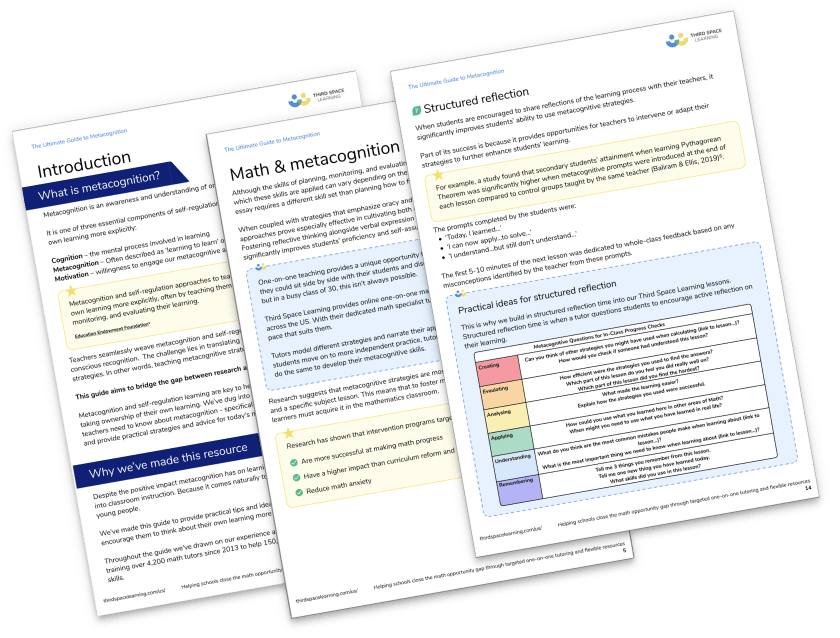How To Increase Parental Engagement In Elementary Schools And Improve Outcomes In Math
Whatever your school community, as a school leader, the issue of parental involvement is likely to feature regularly in your staff, parent and PTA meetings.
Research shows that parental and family engagement really does make the difference in student academic achievement at elementary schools, and it’s up to school administrators to work on community engagement and harness stakeholders as a force for good.
Here we look at some of the ways you can engage parents in their children’s learning and how you can support parents to continue and build on their child’s education at home.
We’re focusing on ways parents can help in math, as that is our specialty area. However, many of the same parent engagement strategies will apply to other subjects.
- Why parents find it hard to engage in math
- What the evidence tells us about parent engagement
- What we as school leaders and teachers can do to support parent engagement
- 1. Build relationships with parents
- 2. Give parents the tools to help
- 3. Model a positive attitude to math
- 4. Teach parents about growth mindset
- 5. Run events to help parents to learn new math teaching methods
- 6. Introduce lots of math games for parents to play with their children
- 7. Find the math in the everyday
- 8. Reward the small successes as well as the big
- 9. Make the most of parent/teacher conferences
- 10. Capture successes on screen with photos and videos
Why parents find it hard to engage in math
It can be particularly hard to encourage family involvement in math homework. Often they complain that they themselves are “bad at math” or that they “never learned anything useful in math at school.”
Unfortunately, some are also willing to say these negative comments in front of their child, which then passes a negative attitude towards math or their ability in math onto the child, with detrimental impact on the child’s education.
Parents sometimes also complain that the mathematics curriculum of children’s schools doesn’t teach their children any life skills, which again can quickly influence a child’s own attitude toward math.
The final most common reason is that parents themselves suffer from math anxiety; they are scared of math or of teaching their child the wrong method or getting the wrong answer.
What the evidence tells us about parent engagement
The National Association for Family, School and Community Engagement (NAFSCE) is the first association focused on advancing family, school, and community engagement.
The NAFSCE lists the following as “high-impact strategies,” which have proven to be the most effective strategies for fostering parent and family engagement in schools:
- Building personal relationships, respect, and mutual understanding with families through home visits, community walks, and class meetings.
- Sharing data with families about student skill levels.
- Modeling effective teaching practices so families can use them at home.
- Listening to families about their children’s interests and challenges, then using this information to differentiate instruction.
- Incorporating content from families’ home cultures into classroom lessons.
- Aligning family engagement activities with school improvement goals. (https://nafsce.org/page/definition)

Meet Skye, the voice-based AI tutor making math success possible for every student.
Built by teachers and math experts, Skye uses the same pedagogy, curriculum and lesson structure as our traditional tutoring.
But, with more flexibility and a low cost, schools can scale online math tutoring to support every student who needs it.
Find out more
What we as school leaders and teachers can do to support parent engagement
1. Build relationships with parents
At the heart of all parental engagement is good relationships with parents. This isn’t always as easy as it sounds for a multitude of reasons that you will be all too aware of. Empathy is key here and an understanding that every family who joins your school comes with their own back story, their own experiences and expectations.
You will have supporters in all areas of the school community. Work with them first and build out from there. And try very hard to put to one side the concept of ‘hard to reach parents’ and avoid judgment. The onus is on us to reach them or find someone else they trust to build the family-school relationship.
2. Give parents the tools to help
Often we need to reassure parents and provide them with the tools to support their child’s learning. Involving parents can be as simple as reminding them of school policies around homework or reading or giving them some useful home learning packs.
Third Space has lots of home learning articles to support parents with math at home, from teaching fractions to kids to working out what PEMDAS means. It is also often helpful in elementary school to explain how much of the curriculum does directly relate to real life.
As a math teacher, I always made sure I wrote down how each of my lessons was related to everyday life so I always had some good examples up my sleeve and never got caught out!
In fact, parents are in the ideal position to build their children’s real life math skills by involving them in real life math problems at home.
Every day, adults have to negotiate math problems around which car insurance company is providing the best deal or comparing a “buy one get one free” deal with a “buy 3 for 2” deal in the supermarket. Encourage them to get their children to try helping them!
So here are some ideas for parent engagement and how you can help parents to help their children with math at home.
3. Model a positive attitude to math
Before any learning can take place at home, some parents will need to change their attitude towards math themselves. Many parents have the attitude that they are “bad at math” and pass negativity about math onto their children.
If parents are at least aware of the effect of this attitude, then they can take steps towards being more positive about math around their children.
4. Teach parents about growth mindset
Parents should be advised that math is not just about getting things “right” every time. A lot of math involves problem solving which is not a quick and easy exercise, as such students need to build up persistence and resilience.
Parents can support this by fostering a supportive learning environment where mistakes are viewed as a normal learning process, rather than a negative experience.
This kind of approach to learning will help parents to enable the child to develop a growth mindset, where the student is more willing to make mistakes and try again. In addition to supporting student learning, a growth mindset will also develop children’s social skills and well-being.
5. Run events to help parents to learn new math teaching methods
Lots of parents want to help their children but are not sure how, or they try to teach their children the methods they learned in school which can confuse students.
Instead, schools can help minimize this confusion by being open with parents about the methods they are using in school programs and could offer to teach parents these methods so they can help support their children at home.
Organize a parents morning session where they can come in and learn from you, or even better, their own children, the new math teaching methods used in classrooms, such as the long division method and the bar model.
This will ensure continuity between school and home learning and lead to a more solid understanding of mathematical methods for the child. It will further develop home-school partnerships.
6. Introduce lots of math games for parents to play with their children
Games can be a really positive way for children to learn – if correctly implemented. Many games actually involve math and can help children with counting, problem-solving, learning shapes and spatial awareness. These can start from early childhood and continue up until high school and adulthood!
Board games are a great way for parents to engage with their children and games such as Snakes and Ladders and chess and even Minecraft can encourage the development of mathematical skills and spatial awareness that are transferable in school!
We’ve also created 25 fantastically fun math games for kids to do at home.
7. Find the math in the everyday
Talking about math is really important for children to practice, as this allows them to develop their mathematical reasoning as a precursor to harder questions. Parents can encourage their children to talk about math in everyday situations, such as prices at the supermarket or counting physical objects.
This is also really useful for helping children understand how math links to the real world.
Advise parents that it’s more useful to develop their child’s questioning – just like school staff would – than to give them the correct answer, even if they’re tempted! Why not provide parents with example questions such as “why did you write that down?” or “how did you get that answer?” so they can then develop their own questioning in the classroom techniques for the benefit of their child.
Remind parents that student success isn’t all about getting the correct answers!
Questioning means that the child can become a more effective independent learner and also master whatever skill or method they are attempting to learn.
8. Reward the small successes as well as the big
Use phone calls home or class certificates not just for the major piece of work or test scores but perhaps for a particular breakthrough in math, or maybe when a child took the time to explain a concept clearly to their learning or talk partner. It is very effective to organize a ‘positive phone call home.’
Ending the school year on a positive note, reflecting on student achievements and what they could do next year is a great way to keep parents engaged.
Particularly in 5th grade, where children and parents will be reflecting on their child’s upcoming transition to middle school, this is a great chance to reflect on wider achievements, not just those in core subjects and not just academic performance.
9. Make the most of parent/teacher conferences
It’s inevitable that some parents won’t be able to attend. For those that do, remember to make it a two-way conversation.
As teachers and school administrators, we should try to encourage parents to reflect on how their child has been doing so far this year with probing questions about their child and their experience of school life.
- Is there anything in particular you think they have engaged well with this year?
- Where do you feel they have made the most improvement?
- What have they spoken to you about at home?
Of course, these may not always elicit positive responses, but it does help build a better relationship. You’ll be amazed how often you’ll make a discovery this way.
10. Capture successes on screen with photos and videos
A lot goes on in schools that parents know nothing about. Capture these class or individual moments on camera to share internally and parents can’t help but be thrilled. If you’re having a school event, such as a play or school assembly, you could display the images as a slideshow in the background.
If teachers are looking for end of year activities, they could task students with creating their own slideshow or video using the photos.
Film each child individually and ask them for their input on what they’ve liked most in the year so far, or what they’ve learned, or achieved or improved on.
Do you have students who need extra support in math?
Skye—our AI math tutor built by experienced teachers—provides students with personalized one-on-one, spoken instruction that helps them master concepts, close skill gaps, and gain confidence.
Since 2013, we’ve delivered over 2 million hours of math lessons to more than 170,000 students, guiding them toward higher math achievement.
Discover how our AI math tutoring can boost student success, or see how our math programs can support your school’s goals:
– 3rd grade tutoring
– 4th grade tutoring
– 5th grade tutoring
– 6th grade tutoring
– 7th grade tutoring
– 8th grade tutoring
The content in this article was originally written by secondary teacher Sophie Waterman-Smith and has since been revised and adapted for US schools by elementary math teacher Katie Keeton.






